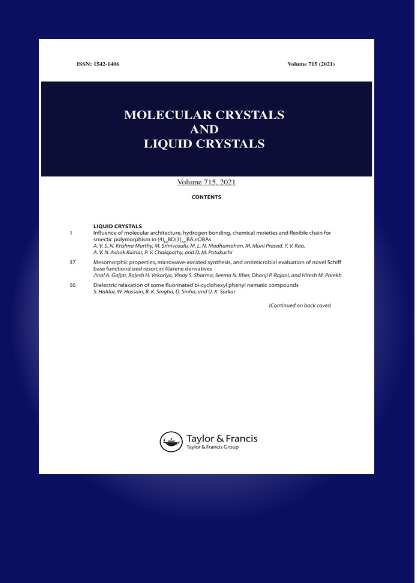Sorption-luminescence method for determination of ytterbium
IF 0.7
4区 化学
Q4 CHEMISTRY, MULTIDISCIPLINARY
引用次数: 0
Abstract
Yb(III) ions, complexed with some organic ligands, exhibit intense luminescence. The light energy is absorbed by the organic part of the molecule of the complex, then there is an intramolecular energy transfer from the organic ligand to the Yb(III) ion. During the sorption of Yb(III) on the solid matrix, the intermolecular energy transfer is suppressed, which provides the increase of the luminescence intensity, and the effect of selective preconcentration is achieved. Promising materials for solid-phase spectrofluorimetry are natural zeolites. Sorbed Yb(III) on these natural nanomaterials retains the ability to interact with organic ligands. In order to develop a sorption-luminescent method for the determination of Yb, the ability to luminescence of Yb(III) ions sorbed on natural Transcarpathian clinoptilolite in combination with 1-(2-pyridylazo)-2-naphthol (PAN) was studied. Luminescence composition «clinoptilolite-Yb(III)-PAN» is observed in the IR region of the spectrum with a maximum λ=978 nm. Luminophore samples were excited by a laser with λ=532 nm. The optimal conditions for obtaining this luminophor have been found. To prepare an effective luminophor «clinoptilolite-Yb(III)-PAN» it is necessary to use precalcined at 300 о C samples of clinoplololite, heated at 50 о C samples «clinoptilolite-Yb(III)», and the final luminophor heated at 50 о C. Sorption of Yb(III) on clinoptilolite is carried out from weakly alkaline solutions at pH 9.0. The developed sorption-luminescent method allows to determine Yb in the presence of 10-fold excess of La(III) and Eu(III), as well as 5-fold excess of Lu(III), Tm(III), Gd(III), Pr(III), Tb(III) with a detection limit of 5.0 ng·mL -1 . The method is tested on model solutions and intermetallics. The method provides a high enrichment factor, a wide concentration range of Yb determination (12.5-1000 ng·mL -1 ).吸附发光法测定镱
Yb(III)离子与某些有机配体配合,表现出强烈的发光。光能被配合物分子的有机部分吸收,然后从有机配体到Yb(III)离子发生分子内能量转移。在固体基质上吸附Yb(III)的过程中,抑制了分子间的能量传递,从而提高了发光强度,实现了选择性预富集的效果。天然沸石是固相荧光光谱法的理想材料。吸附在这些天然纳米材料上的镱(III)保留了与有机配体相互作用的能力。为了建立一种吸附-发光测定Yb的方法,研究了Yb(III)离子与1-(2-吡啶偶氮)-2-萘酚(PAN)在天然喀尔巴阡斜沸石上吸附的发光能力。发光成分“斜发沸石- yb (III)-PAN”在红外光谱区观察到,最大λ=978 nm。用λ=532 nm的激光激发发光团样品。找到了制备该发光材料的最佳条件。为了制备有效的发光材料“斜发沸石-Yb(III)-PAN”,必须使用300°C预煅烧的斜发沸石样品,50°C加热的斜发沸石样品“斜发沸石-Yb(III)”,最后在50°C加热的发光材料。在pH为9.0的弱碱性溶液中,斜发沸石吸附Yb(III)。所建立的吸附发光法可以在La(III)和Eu(III)超标10倍的情况下测定Yb,在Lu(III)、Tm(III)、Gd(III)、Pr(III)、Tb(III)超标5倍的情况下测定Yb,检出限为5.0 ng·mL -1。该方法在模型溶液和金属间化合物上进行了验证。该方法富集系数高,测定Yb的浓度范围宽(12.5 ~ 1000 ng·mL -1)。
本文章由计算机程序翻译,如有差异,请以英文原文为准。
求助全文
约1分钟内获得全文
求助全文
来源期刊
CiteScore
1.20
自引率
14.30%
发文量
248
审稿时长
2 months
期刊介绍:
Established in 1966, Molecular Crystals and Liquid Crystals is a world-leading journal publishing original research papers in both an experimental and theoretical nature in three areas of specialization: liquid crystals, molecular crystals, and low-dimensional solids. These cover, but are not limited to:
Liquid Crystals:
-Electro- and magneto-optical phenomena; thermodynamics; phase transitions; structure; NMR and orientation-controlled spectroscopy; theory.
Molecular Crystals:
-Spectroscopy; energy and charge transfer; solid state reactions; photo and radiation effects
Low-dimensional Solids:
-Structure, electronic, magnetic, and optical properties; transport mechanisms
The journal publishes research papers, review papers, and book reviews. In all three areas, experimental manuscripts describing both preparation and properties will be considered. Papers that describe determination of crystal structure alone are not encouraged unless some solid state forces (hydrogen bonding, charge transfer, etc.) are playing a significant role and/or some solid state properties of the materials are measured.

 求助内容:
求助内容: 应助结果提醒方式:
应助结果提醒方式:


